Recently, induction cookers are gaining popularity, and for good reason: they save energy due to a special heating system, are easy to maintain and safe – because the stove simply will not work if there are no dishes on it. And yet, the induction cooker is noticeably more expensive than conventional electric or infrared. Today we take a look at the Lex hob – EVI 430 BL – and find out if the game is worth the candle.
Lex is a new manufacturer for us, and this is the first product of the brand that we have to get acquainted with. So far, we know that the company produces hoods and built-in household appliances, operates in the budget price segment and offers interesting warranty services. So, let’s get acquainted with the first device.

Characteristics
| Manufacturer | Lex |
|---|---|
| Model | EVI 430BL |
| Type | induction hob |
| Country of Origin | China |
| Warranty | 36.6 months (3 years and 18 days) |
| Service life * | 10 years |
| Material | glass-ceramic Kanger |
| Control | sensory |
| Power | 5500 W |
| Number of burners | 3 |
| Burner power | 2×2000W, 1×1500W |
| Burner diameter | 2×18 cm, 1×16 cm |
| Security features | overheating protection, automatic shutdown by time, detection of small particles, residual heat indicator |
| Control functions | timer, 99 minutes (reminder function, switching off one heating zone after the time has elapsed) |
| Net weight | 7.5 kg |
| Shipping Weight | 8.5 kg |
| Dimensions (W×H×D) | 450×60.5×520 |
| Niche size for embedding | 425×490 mm |
| Network cable length | 1.05 m |
| Recommended price at the time of publication of the article | about 21 thousand rubles |
* If it’s quite simple: this is the period during which parts for repairing the device are delivered to official service centers. After this period, any repair in the official SC (both warranty and paid) is unlikely to be possible.
Equipment
The panel arrived to us in a corrugated cardboard box, on which we see the name of the model, its image and several pictograms informing about the functions of the device.

Opening the box, inside we found:
- the panel itself with a pre-installed electrical cord, but without a plug,
- 4 screws and 4 brackets,
- instructions and warranty card.

At first sight
We did not find anything unusual in the appearance of our today’s ward: a surface made of dark glass (looking black, but turned out to be dark orange in the light), on which heating zones are indicated in gray – in this case, these are not circles, but cruciform marks. At the bottom there is a touch panel: one glance at it is enough to understand that the EVI 430 BL has few additional functions – only a timer and blocking. And, well, except that the size is non-standard: the width of the hob is only 45 centimeters.
Turning over the panel, we found two fans and a sticker with technological information.

Instruction
The 35-page user manual begins with general safety instructions and then gets a bit confusing in its composition. The instruction is devoted to five models at once, and in order to find the necessary information, you have to carefully look through the book.

At the same time, some general points (for example, what dishes can be used and how to determine them) for some reason are in the section on the first three models. Luckily, the EVI 430 BL was just one of them, so in this case the manufacturer did not manage to confuse us.
And yet, having understood this strange system (or rather, some of its absence), you can find in the instructions all the information necessary for work. It even has cooking tips and a table describing the purpose of the heat levels. So, for pancakes, they suggest choosing level 5-6, and for gentle languor – 1-2. True, at this moment some doubts crept in: for example, for stewing, that is, long-term cooking at low temperatures, it is proposed to choose a degree of 7-8 with a maximum of 9.
As a bonus, it describes in some detail how to cook a “seasoned steak”.
Control
Controlling the panel is easy. How to choose a burner and power is intuitive: turn it on, click on the icon of the corresponding burner, use the “+” or “-” buttons to adjust the degree of heating.

The timer can be set as a signal or set the operating time for an individual burner: after the expiration of the period, it will turn off, and the rest will continue to work. The power can be adjusted – the timer will not be reset. To set the operating time of a certain heating zone, select it, when the indicator flashes, click on the timer icon and set the required number of minutes using the “+” and “-” buttons.
In order to prevent accidental switching on (by children, for example), a lock function is provided: when it is activated, only the on / off button works. The function is activated by a short press on the icon with a lock, it is turned off by a long press on it (the stove can be turned off).
The panel is equipped with an automatic shutdown function if the power has not been adjusted for a long time. The permissible operating time depends on the degree of heating.
| Degree of heating | one | 2 | 3 | 4 | 5 | 6 | 7 | eight | nine |
|---|---|---|---|---|---|---|---|---|---|
| Maximum operating time, h | eight | eight | eight | 4 | 4 | 4 | 2 | 2 | 2 |
Connection
The connection was not difficult, since we had few options: there were … two wires sticking out of a thick rubber-like braid at the end of the power cable. The manufacturer claims that everything is covered with plastic on the reverse side, so there is no need for grounding.
Exploitation
We didn’t have any problems using the EVI 430 BL. Moreover, the panel is not burdened with a large number of functions that would have to be understood.
An indisputable plus of induction cookers is speed. The frying pan heats up in seconds, the eggs in the ladle boil in a minute. Just as rapidly, however, everything starts to boil away, if the power is not promptly reduced. Empirically, we have found that for cooking soup or stewing, the optimal power level for the EVI 430 BL is 3-4, active boiling already begins from 5. (Here our doubts about extinguishing for 7-8 were confirmed, as the instructions recommended.)
But even if something spilled over the edge of the pan or fell out of the pan, eliminating the consequences is as easy as shelling pears, and this is another advantage of induction: it is not the burner that is heated, but the bottom of the dishes, which means that nothing burns to the hot surface (in the absence of one) .
When adjusting the power, the degree of heating changes instantly, both up and down. If you turn off the burner under a pot of boiling water, the boiling process stops at the same moment, while on a conventional electric stove, a heated burner does not allow the contents of the dishes to “calm down” for a long time.
In general, we can say that the EVI 430 BL easily copes with the preparation of a wide variety of dishes. During testing, we entrusted it with the classics of Russian home cooking (for example, cabbage soup), and more complex exotics (a wok that requires a constant high temperature) – the panel coped with all tasks.
Without problems, you can cook on three burners at once: two frying pans and a wide saucepan did not interfere with each other at all. Although elongated dishes such as ducklings should not be used here: the maximum diameter of the burner is 18 cm, and outside of it, the dishes simply will not heat up.
And yet, I must say, we noticed that the heat was not always distributed evenly. Of course, you can move the dishes so that the “uncovered” areas also receive their portion of proper heating, but the sediment, as they say, remains. The photo shows what we mean.

The “small particle detection” feature brought to mind the Large Hadron Collider and quarks, but it turned out to be just a detection of missing cookware on the burner or its inadequacy. If you suddenly forgot and put the wrong pan on the stove, the corresponding indicator will light up, and after a minute the panel will simply go into standby mode. The same story will happen if the stove is turned on by accident – an empty burner will not heat up.

One problem is that there is no sound signal for such a shutdown, so the stove will, of course, turn off, and you may not know about it if you are distracted.
Care
In case of light daily soiling (fingerprints, overflow of unsweetened food), it is enough to wipe the panel with a soft cloth or sponge.
In more serious situations (something has melted or some sweet substance has spilled), it is necessary to use a special scraper for glass ceramics.
If liquid is spilled on the touch panel, you must first wipe it with an absorbent device, and then wipe it dry with a paper towel. The sensors are sensitive, so the stove may turn off when you wipe it.
Our measurements
When switched off, the hob connected to the mains consumes 0.04 watts. Included with idle burners – 0.05 W.
We measured the power consumption of two types of burners in each of the available modes. In the “lower” modes, as expected, there is a pulsed power modulation, so for them we give the value of the power consumption and the duration of the on, as well as the duration of the pause following the on, when the heating is turned off.
The average power was calculated according to the formula: power consumption × on duration / (on duration + pause duration).
1500 W burner:
| Mode | Power consumption, W | On duration, s | Pause duration, s | Average power, W |
|---|---|---|---|---|
| one | 520 | 3 | 7 | 156 |
| 2 | 910 | 4 | 6 | 364 |
| 3 | 1000 | 5 | 5 | 500 |
| 4 | 1000 | 6 | 4 | 600 |
| 5 | 1000 | eight | 3 | 727 |
| 6 | 1000 | nine | one | 900 |
| 7 | 1000 | — | — | 1000 |
| eight | 1190 | — | — | 1190 |
| nine | 1550 | — | — | 1550 |
In graph form, it looks like this:

2000 W burner:
| Mode | Power consumption, W | On duration, s | Pause duration, s | Average power, W |
|---|---|---|---|---|
| one | 900 | 3 | 7 | 270 |
| 2 | 1080 | 4 | 6 | 432 |
| 3 | 1080 | 5 | 5 | 540 |
| 4 | 1080 | 6 | 4 | 648 |
| 5 | 1080 | eight | 3 | 785 |
| 6 | 1080 | nine | one | 972 |
| 7 | 1430 | — | — | 1430 |
| eight | 1700 | — | — | 1700 |
| nine | 2050 | — | — | 2050 |
In graph form, it looks like this:
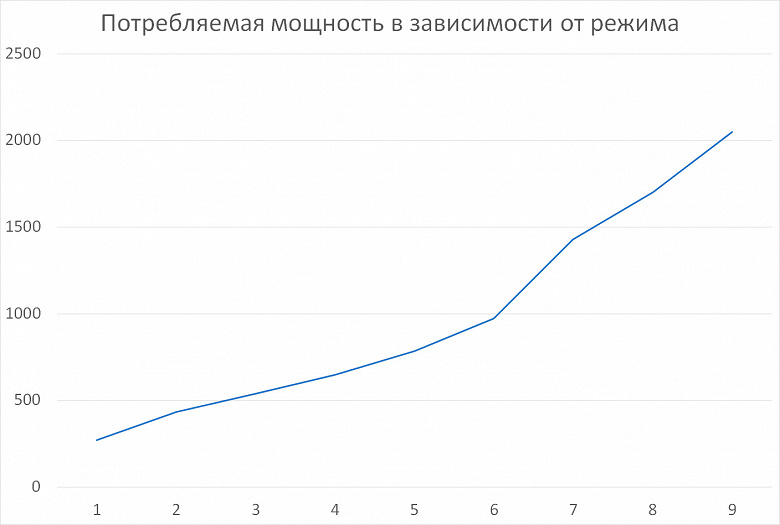
As we can see, despite the difference in power, the behavior of both burners is very similar: the graph, of course, cannot be called a straight line, but it is quite close to it. In fact, this means the most logical behavior: the heating increases smoothly and with each next step by approximately the same amount.
We carried out a standard boil test: 1 liter of water at a temperature of 20 ° C was placed on one of the burners 2000 W in mode 9. The water boiled after 3 minutes 50 seconds. Energy consumption was 0.13 kWh.
Additionally, we were interested in the noise level, since the hob, apparently, does not know how to regulate the speed of rotation of the cooling fans or turn off one of them: even if only one burner is working at the minimum power level, the noise is still the same as when all three are turned on. The measured noise level was 60 dBA.
practice tests
So, to test our ward for strength, we chose the following dishes:
- Scrambled eggs
- Sour cabbage soup
- Aspic
- Draniki
- Chicken in a wok
- Loose buckwheat porridge
Scrambled eggs
An elementary test to check if the surface heats up evenly. We heated the pan in mode 5, threw a little butter mixed with coconut oil on it, as soon as it dispersed, we broke the eggs.
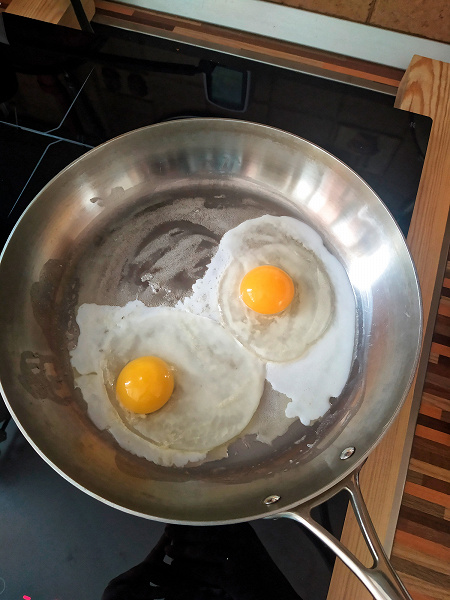
At first, mode 6 was chosen, as soon as the protein grabbed at the edges, they lowered it to 4. The keen eye of the tester noticed that the far part of the scrambled eggs was fried a little slower than the near one. In fairness, the lag was insignificant, so after 5 minutes we got an excellent fried egg: a delicate protein without a hint of “snot” so unloved by many and a perfect liquid yolk.

For 7 minutes of operation, power consumption was 0.07 kWh.
Result: good.
Sour cabbage soup
What Russian cuisine can do without rich cabbage soup! And for us, this is also a great way to check how the hob behaves in multitasking conditions, because while the broth is being cooked, we will need to fry and stew sauerkraut.

So broth. A good piece of beef with a marrow bone was poured with water and brought to a boil over high heat. The foam was carefully removed, the onion stuffed with cloves, carrots, a piece of celery root, a bouquet of garni were thrown into the meat and left to cook over low heat under a slightly ajar lid.

While the broth was cooking (it took a little over two hours), we made the rest of the necessary preparations. They poured dry mushrooms with hot water, then grated carrots, chopped onions and began to brown them in oil, adding a little later soaked and chopped mushrooms. There was sauerkraut stewed in the next frying pan.
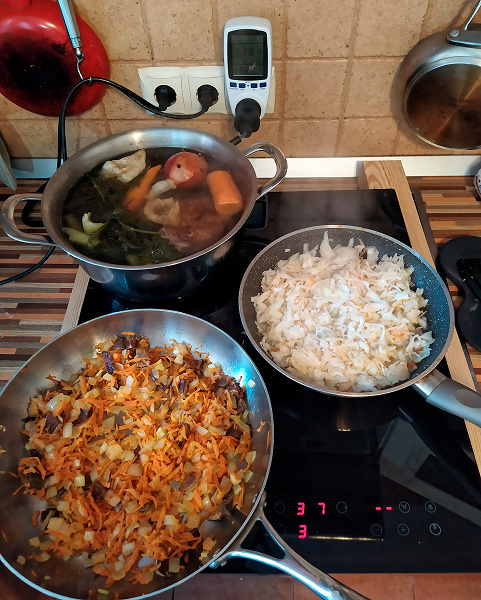
The finished broth was filtered and some more dry mushrooms were thrown into it, but this time ground into powder, and potatoes. When it was almost cooked, they added fried meat, removed from the bone and chopped meat, and a little later, stewed cabbage. And then they threw in raw sauerkraut for a sharp taste. Well, a little dried dill for complete happiness. Everything about everything took us 3.5 hours. During this time, according to the readings of the wattmeter, the energy consumption was 2.2 kWh, and the maximum recorded power was 2490 watts.
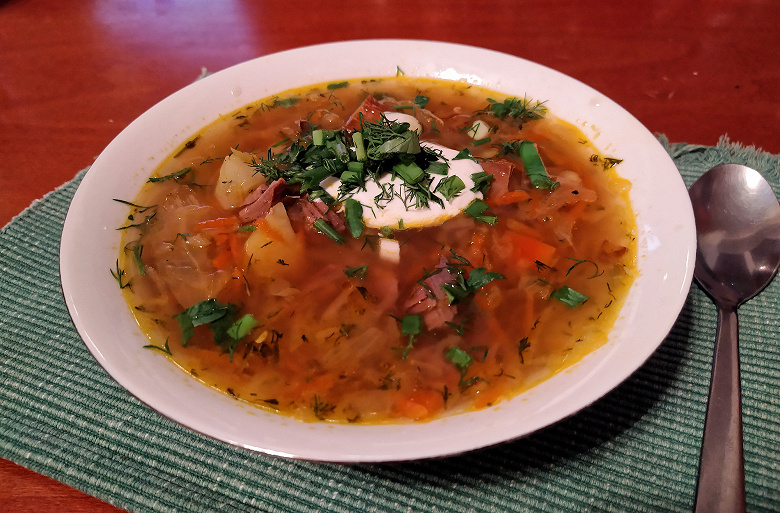
Result: excellent.
Aspic
The peculiarity of the preparation of jelly (and we are talking about real jelly, without the scam in the form of adding gelatin) is that the broth must be boiled for several hours, gurgling measuredly. A great way to check if the slab is able to balance on this thin edge.

A kilogram piece of a veal leg was poured with three liters of filtered water and brought to a boil. After removing the foam, onion and carrots, celery stalk, bay leaf, allspice were added to the broth, baked in a dry frying pan, and over low heat (in this case it was mode 3) left with a slightly ajar lid for 7 hours. From time to time I had to turn the pan: as already mentioned, the burners sometimes heat up unevenly, and while the broth boiled on one side, on the other it began to be covered with a film. Sometimes we had to turn the power up to 4 to spice up our brew, then back down to 3 to keep up the pace. After 7 hours, the broth, as planned, was reduced by half. During this time, energy consumption amounted to 3.1 kWh, the maximum recorded power was 3696 watts.
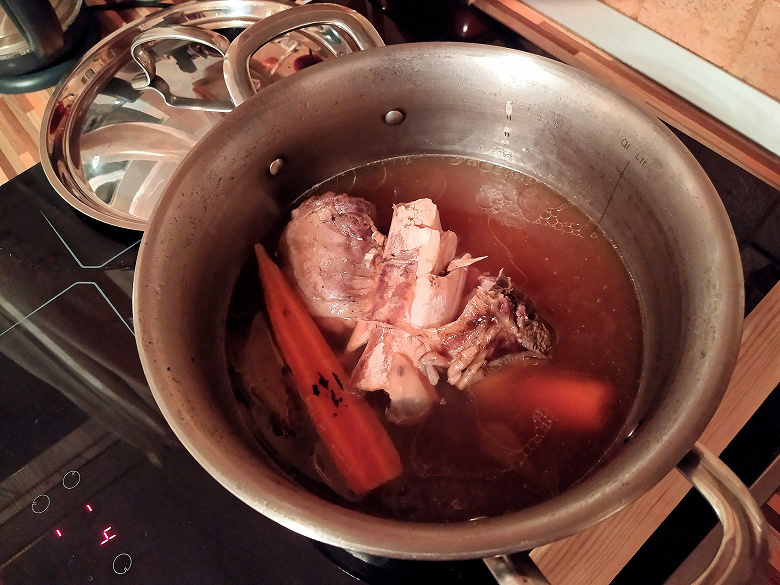
We threw chopped garlic into the broth and, without taking out the meat, sent it to cool a bit. Fat was removed from the chilled broth, the broth itself was filtered. The meat was disassembled into fibers, placed in a bowl, poured with broth and put in the refrigerator.
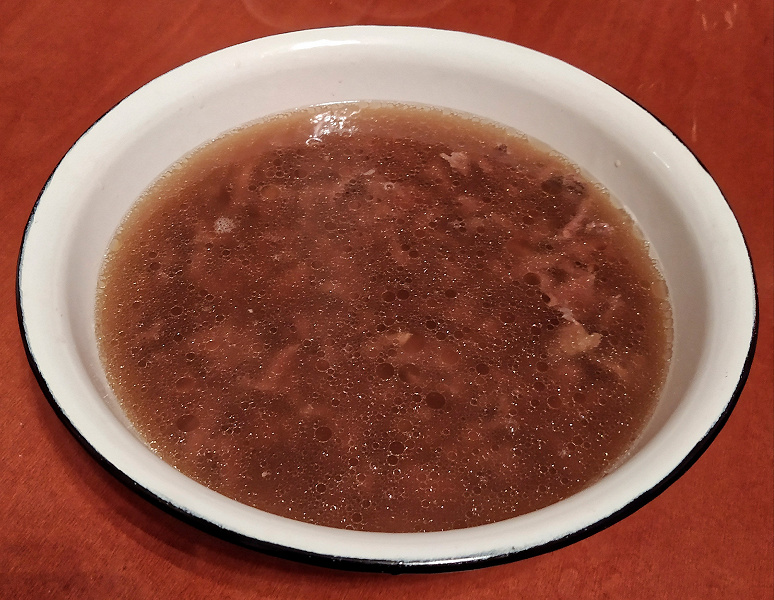
In the morning, a perfect transparent and elastic jelly was waiting for us.
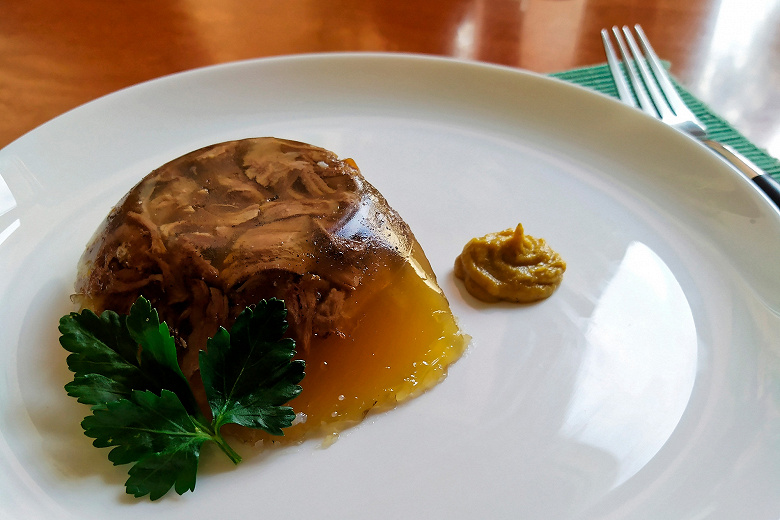
Result: excellent.
Draniki
Grated 6 medium potatoes and one onion, crushed a large clove of garlic into the future dough, added an egg and a tablespoon of flour. We heated a frying pan with vegetable oil and began to fry our potato pancakes.

Turning the pancakes over, we again noticed that there was a slight uneven frying, so we kept this in mind in the future and periodically turned the pan.

In total, we got 12 potato pancakes, we spent 30 minutes and 0.6 kWh on them (we worked at the 7th power mode, sometimes dropping to the 5-6th so that the pancakes “reached”).

Result: good.
Chicken in a wok
A wok is a great stress test for a stove to see if it can maintain a constant heat.

Today we took 400 grams of chicken fillet and marinated it in a mixture of soy and oyster sauces, sprinkled with a little cornstarch. The chicken was put aside and the vegetables were cut: the onion was cut into feathers, the carrots and red bell peppers were cut into strips.
Oil was heated in a wok at maximum power, chicken was thrown into it. The juices from the meat were actively boiling, hissing and evaporating, so we got exactly what we were looking for: a quick fry. It turned out that mode 9 is even too much, so they reduced it to 7.
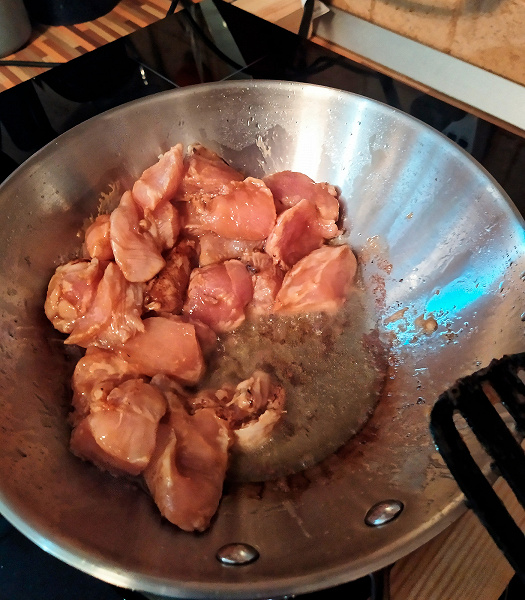
The finished chicken was laid out from the wok. By this time, the kettle had boiled – hot water was poured over funchose for a side dish. And a little more oil was poured into the wok and a chopped piece of ginger and garlic were thrown into it. When the garlic began to change color, carrots were loaded, after a couple of minutes – onions, and a little later – peppers. When the vegetables were fried, but not yet softened, they added a tablespoon of honey, splashed with soy sauce, returned the chicken to the wok and warmed everything together for a couple of minutes. The stove worked for 20 minutes, the energy consumption was 0.03 kWh.

Result: excellent.
Loose buckwheat porridge
In the end, we decided to take a swing at our William Pokhlebkin and cook buckwheat porridge according to his method. We often use this recipe at home, and its peculiarity is that the time and strength of the fire on which the porridge is cooked are strictly defined here. Groats are placed in a dish with a thick bottom, poured with water in a ratio of 1: 2, dry mushrooms ground into powder are sent there. The pan is tightly closed with a lid that must not be removed during the entire cooking time: the steam formed inside is the most important participant in the process, and it is not necessary to release it.
So, at maximum heat, bring the porridge to a boil, then reduce the heat to low and wait 10 minutes, after which we cook for another 5-7 minutes at the lowest heat until the water is completely evaporated. After that, do not open the lid, but leave the porridge in a warm place for 15 minutes.

In parallel, we prepare the dressing: boil hard-boiled eggs, and fry the onion until golden brown, salt. When the porridge is suitable, gently mix the onion and finely chopped eggs into it, without crushing. You can add more salt at this stage if you like.
Our test showed that in the case of the EVI 430 BL, what Pokhlebkin calls medium fire is still not the middle of the power scale. At both 5 and 4, a very strong boil continued in the saucepan, and some of the water even splashed onto the panel. The same story with eggs: it was possible to calm down the water, which strove to run over the edge, only by 3. They brought porridge in mode 1. In 20 minutes of operation, the stove consumed 0.37 kWh, the maximum power was 2740 watts.
One way or another, having danced a little around the stove with a tambourine, we got a tasty and crumbly buckwheat porridge, which can be served both as a side dish and as a separate dish.

Result: excellent with a minus.
findings
Well, the EVI 430 BL hob is more of an A student than a good one. Sometimes, of course, he relaxes, but this does not affect the GPA.

She copes with everyday tasks without problems, but even more intricate “homework”, having adapted a little, clicks like nuts.
Induction allows in some cases to significantly reduce the cooking time: the dishes (and, consequently, their contents) heat up much faster than on a conventional electric stove. The Boost function would speed up the process even more, but, unfortunately, it is not here.
The panel is easy to clean, most often it is enough to walk with a damp cloth and wipe dry with a paper towel.
Not once during the tests did we record a power that even remotely resembles the declared maximum of the EVI 430 BL.
All in all, this hob is a great choice for those who are looking for a good, but no-fuss, and budget-friendly cooker for everyday cooking, which is also capable of something more than cabbage soup and porridge. And the compact size also saves space in a small kitchen.
pros
- compact
- inexpensive
- easy to care for
- performs all basic functions
- allows you to work at high temperatures
Minuses
- no Boost function
- when frying piece products, you need to adapt




